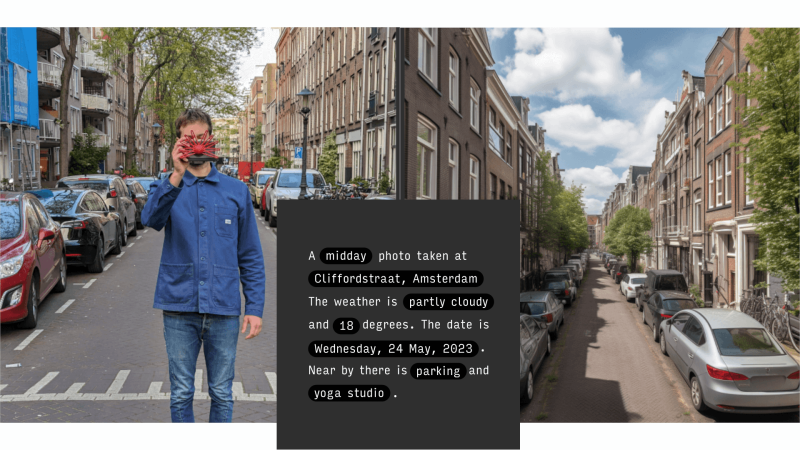These days, every phone has a camera, and few of us are ever without one. [Bjørn Karmann] has built an altogether not-camera, though, in the form of the Paragraphica, powered by artificial intelligence.
The Paragraphica doesn’t actually take photographs at all. Instead, it uses GPS to determine the user’s current position. It then feeds the address, time of day, weather, and temperature into a paragraph which serves as a prompt for an AI image generator. It also uses data gathered from various APIs to determine points of interest in the immediate area, and feeds those into the prompt as well. It then generates an artificial image that is intended to bear some resemblance to the prompt, and ideally, the real-world scene. In place of a lens, it bears a 3D printed structure inspired by the star-nosed mole, which feels its way around in lieu of using its eyes.

Three dials on the Paragraphica control its action. The first dial controls the radius of the area which the prompt will gather data about; it’s akin to setting the focal length of the lens. The second dial provides a noise seed value for the AI image generator, and the third dial controls how closely the AI sticks to the generated textual prompt.
The results are impressive, if completely false and generated from scratch. The Paragraphica generates semi-believable photos of a crowded alley, a public park, and a laneway full of parked cars. It’s akin to telling a friend where you are and what you’re seeing over the phone, and having them paint a picture based on that description.
Through their unique abilities and stolen data sets, AI image generators are proving controversial to say the least. As all good art does, Paragraphica explores this and raises new questions of its own.

















Thanks, I hate it.
A thought-proking idea with great execution, well done. I also hate it.
Talk about completely out of the box thinking! I just spent over $8k upgrading my camera kit to mirrorless, so of course I hate it.
The outer limits demonstrated that with control of the horizontal and the vertical one could make people believe many things.
Soon the likes of Getty Images will be completely obsolete. It makes no sense to use real models to take hundreds of pictures, when the customer can just enter their own prompt, and generate only the images they need, fully customized.
I’d be willing to pay an extra surcharge to know that the images/people I am seeing are real.
Great project, very creative use of AI.
Ah, but what’s real? Doesn’t makeup distort reality in photographs? Automatic camera filters? And then there is the photoshopping and insta-filters. Even what you see might not be “real” somebody else might see it differently, it’s just your perception of a person, situation.
Stock in Getty has plummeted since the fall of last year. It WAS hovering around $30/share and is now under $4. Stock photo agencies are now dead businesses. I think the only way forward for them would be to create their OWN ai image generator using their images as source material (like Adobe has done with Firefly). I’m writing about AI and new tools at flink.ca. Drop by and have a read. :)
It’s like a metadata version of this previous project, which does the same but from an actual photo. Pretty cool!
https://hackaday.com/2023/02/25/this-camera-produces-a-picture-using-the-scene-before-it/
I’m pretty surprised that it managed to generate semi-credible bicycles in the first picture… somehow AI managed to handle bicycles but not crosswalks, did they have enough bicycle captchas but not enough crosswalk captchas already? LOL
I was pretty surprised to see so many Buddhist monks in Westerstraat, Amsterdam.
B^)
That king’s-day picture looks creepy because all the men are the same height (and weight/posture).
And as you noted in jocular form, the orange-outfit adoption was a bit overestimated.
A normal camera eliminates the need for “imagination” from an AI in determining points of interest within the field of view of what it’s pointed at.
Why use a camera? It flattens the human experience of being somewhere, simply travel wherever you’re thinking of and use your eyes.
“simply travel wherever you’re thinking of and use your eyes”
Therein lies the rub, my teleporter is broken and I can’t get the repair parts from Vega 6a without it.
Why build that thing and lug it to the location you want a “photo” of? Enter the GPS coordinates of the desired location along with a bearing and time-of-day into a web (or mobile) app that generates the required text and feeds it into the “AI”. The “photo” gets generated and displayed for download…
If you go to the website it will do our browser’s location, though it seems us visitors have exceeded their prompt budget.
Regardless, the prompt is in one of the article’s pictures. You could always access a weather and maps API to fill in the blanks yourself, and feed it through an AI API to get a picture. But that won’t capture the same physical fun of pressing the physical “shutter” button.
I can honestly say this is the first time I’ve posted a comment on Hackaday…but my disgust for this particular device pushed me to some previously unknown limit…I hate this thing, as well…
Hey AI, make a picture of Greg Howell reading this article with disgust and dismay on his face.
Sorry, but curiousity is a bitch :)
Yeah, you may hate it, but imagine it in a few years, when the world will be even more digitalized (5G, etc), and when AI will be even more predictive. It’ll know who is in there, what cars and what other stuff (tracked thru 5G because…), and so on. It will be able to reconstruct an image very close to the reality. And they, with a forward button, you will be able to see how this image evolves next ! You will be able to take pictures in the future! Pre-cog :-)